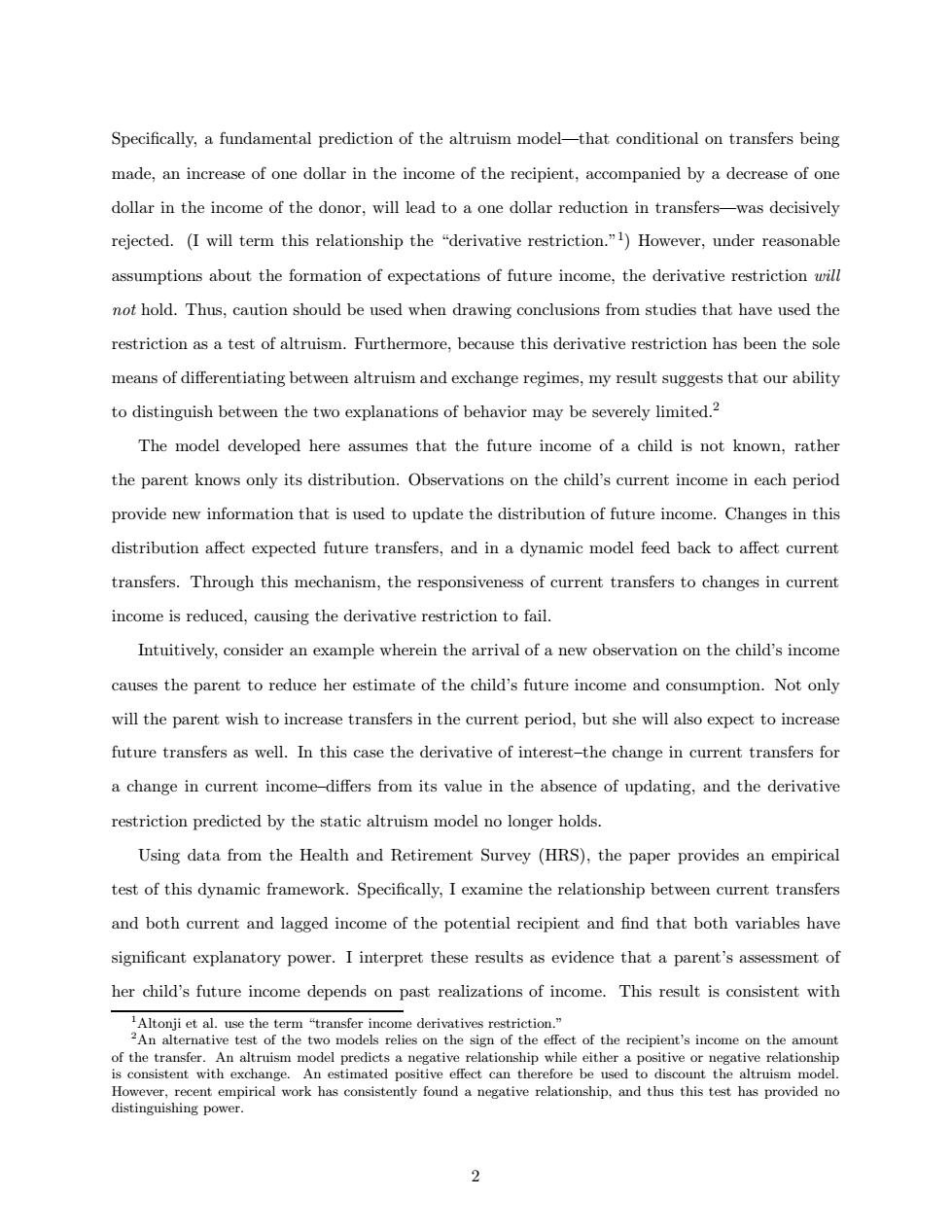正在加载图片...

Specifically,a fundamental prediction of the altruism model-that conditional on transfers being made,an increase of one dollar in the income of the recipient,accompanied by a decrease of one dollar in the income of the donor,will lead to a one dollar reduction in transfers-was decisively rejected.(I will term this relationship the "derivative restriction."1)However,under reasonable assumptions about the formation of expectations of future income,the derivative restriction will not hold.Thus,caution should be used when drawing conclusions from studies that have used the restriction as a test of altruism.Furthermore,because this derivative restriction has been the sole means of differentiating between altruism and exchange regimes,my result suggests that our ability to distinguish between the two explanations of behavior may be severely limited.2 The model developed here assumes that the future income of a child is not known,rather the parent knows only its distribution.Observations on the child's current income in each period provide new information that is used to update the distribution of future income.Changes in this distribution affect expected future transfers,and in a dynamic model feed back to affect current transfers.Through this mechanism,the responsiveness of current transfers to changes in current income is reduced,causing the derivative restriction to fail. Intuitively,consider an example wherein the arrival of a new observation on the child's income causes the parent to reduce her estimate of the child's future income and consumption.Not only will the parent wish to increase transfers in the current period,but she will also expect to increase future transfers as well.In this case the derivative of interest-the change in current transfers for a change in current income-differs from its value in the absence of updating,and the derivative restriction predicted by the static altruism model no longer holds. Using data from the Health and Retirement Survey (HRS),the paper provides an empirical test of this dynamic framework.Specifically,I examine the relationship between current transfers and both current and lagged income of the potential recipient and find that both variables have significant explanatory power.I interpret these results as evidence that a parent's assessment of her child's future income depends on past realizations of income.This result is consistent with Altonji et al.use the term "transfer income derivatives restriction." 2An alternative test of the two models relies on the sign of the effect of the recipient's income on the amount of the transfer.An altruism model predicts a negative relationship while either a positive or negative relationship is consistent with exchange.An estimated positive effect can therefore be used to discount the altruism model. However,recent empirical work has consistently found a negative relationship,and thus this test has provided no distinguishing power. 2Specifically, a fundamental prediction of the altruism model—that conditional on transfers being made, an increase of one dollar in the income of the recipient, accompanied by a decrease of one dollar in the income of the donor, will lead to a one dollar reduction in transfers—was decisively rejected. (I will term this relationship the “derivative restriction.”1) However, under reasonable assumptions about the formation of expectations of future income, the derivative restriction will not hold. Thus, caution should be used when drawing conclusions from studies that have used the restriction as a test of altruism. Furthermore, because this derivative restriction has been the sole means of differentiating between altruism and exchange regimes, my result suggests that our ability to distinguish between the two explanations of behavior may be severely limited.2 The model developed here assumes that the future income of a child is not known, rather the parent knows only its distribution. Observations on the child’s current income in each period provide new information that is used to update the distribution of future income. Changes in this distribution affect expected future transfers, and in a dynamic model feed back to affect current transfers. Through this mechanism, the responsiveness of current transfers to changes in current income is reduced, causing the derivative restriction to fail. Intuitively, consider an example wherein the arrival of a new observation on the child’s income causes the parent to reduce her estimate of the child’s future income and consumption. Not only will the parent wish to increase transfers in the current period, but she will also expect to increase future transfers as well. In this case the derivative of interest–the change in current transfers for a change in current income–differs from its value in the absence of updating, and the derivative restriction predicted by the static altruism model no longer holds. Using data from the Health and Retirement Survey (HRS), the paper provides an empirical test of this dynamic framework. Specifically, I examine the relationship between current transfers and both current and lagged income of the potential recipient and find that both variables have significant explanatory power. I interpret these results as evidence that a parent’s assessment of her child’s future income depends on past realizations of income. This result is consistent with 1Altonji et al. use the term “transfer income derivatives restriction.” 2An alternative test of the two models relies on the sign of the effect of the recipient’s income on the amount of the transfer. An altruism model predicts a negative relationship while either a positive or negative relationship is consistent with exchange. An estimated positive effect can therefore be used to discount the altruism model. However, recent empirical work has consistently found a negative relationship, and thus this test has provided no distinguishing power. 2